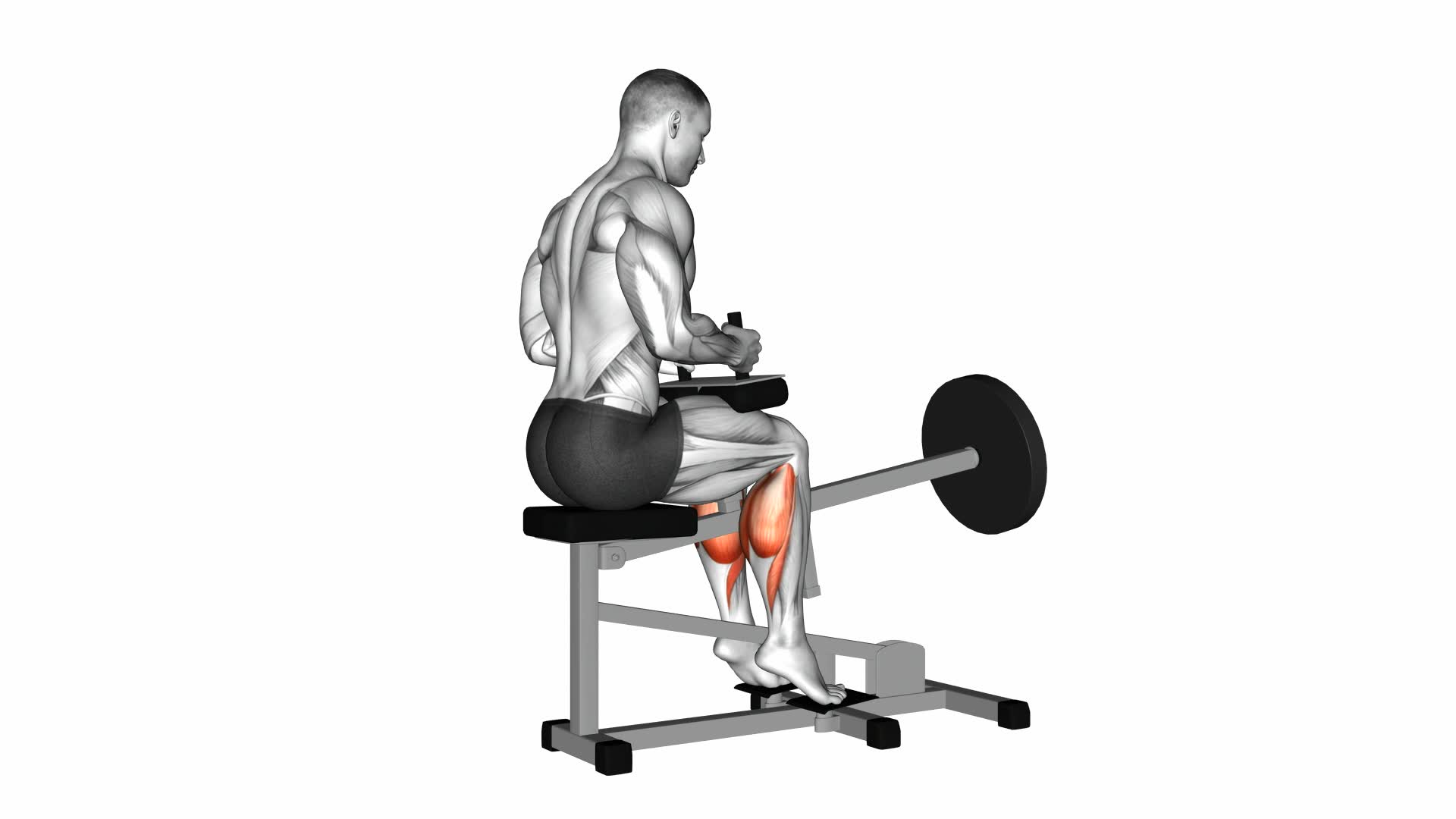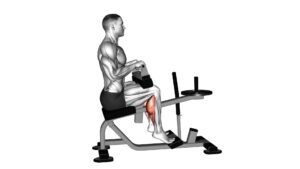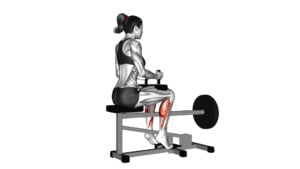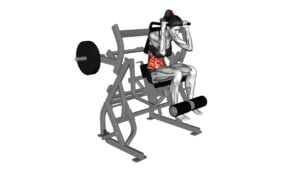Lever Seated Calf Raise (Plate Loaded) – Video Exercise Guide & Tips

Are you looking to strengthen and tone your calf muscles? Look no further than the lever seated calf raise! In this video exercise guide, we'll show you the proper form and technique to perform this effective exercise.
Watch This Exercise Video
You'll also learn about the benefits, equipment needed, variations, and common mistakes to avoid.
Get ready to maximize your calf gains and achieve those sculpted legs you've always wanted. Let's get started!
Key Takeaways
- Lever Seated Calf Raise targets calf muscles for strength and definition.
- Proper foot placement is crucial for optimal muscle activation.
- Avoid common mistakes such as using momentum or not fully extending ankles.
- Gradually increase weight and perform slow and controlled movements for best results.
Benefits of Lever Seated Calf Raise
You can achieve stronger and more defined calf muscles by incorporating the lever seated calf raise into your workout routine. This exercise specifically targets the calf muscles, helping to develop greater strength and definition in this area. Calf muscle development is important not only for aesthetic reasons but also for functional purposes. Strong calf muscles contribute to better balance and stability, which can enhance your performance in various activities such as running, jumping, and even everyday tasks like walking or climbing stairs.
In addition to improving calf muscle development, the lever seated calf raise offers several other strength training benefits. By using a loaded plate, you can progressively increase the resistance and challenge your calf muscles to adapt and grow stronger over time. This exercise also engages the lower leg muscles, including the soleus and gastrocnemius, which can help improve lower body strength and power. Furthermore, the seated position of this exercise minimizes the involvement of other muscle groups, allowing you to isolate and target the calf muscles more effectively.
To perform the lever seated calf raise, you'll need a lever calf raise machine and a weight plate. The setup involves adjusting the machine to your desired height and selecting an appropriate weight. By following proper form and technique, you can maximize the effectiveness of this exercise and achieve optimal calf muscle development.
Equipment and Setup
To ensure a successful lever seated calf raise, it's important to select the proper equipment and set up correctly.
Choosing the right lever machine that's suitable for your body size and weight is crucial for optimal results and safety.
Additionally, setting up the machine according to your height and comfort level will help you maintain proper form throughout the exercise.
Proper Equipment Selection
When selecting the proper equipment and setting up for a lever seated calf raise (plate loaded), it's important to consider the weight capacity and adjustability of the machine. Here are some key points to keep in mind:
- Weight capacity: Ensure that the machine can handle the amount of weight you plan to use. This will prevent any accidents or damage to the equipment.
- Adjustability: Look for a machine that allows you to adjust the seat and foot platform height. This will help you find the proper range of motion for your calves.
- Proper form: Using the right equipment will enable you to maintain proper form throughout the exercise. This ensures that you target the calf muscles effectively and minimize the risk of injury.
- Importance of foot placement: The position of your feet on the foot platform can impact the muscles targeted during the exercise. Experiment with different foot placements to find what works best for you.
Set up for Success
To set yourself up for success in your lever seated calf raises, ensure that you have the proper equipment and setup.
First and foremost, it's crucial to warm up before starting any exercise routine. This helps increase blood flow to the muscles, improves flexibility, and reduces the risk of injury.
Before performing the lever seated calf raise, it's recommended to start with a warm-up set using lighter weight or bodyweight exercises. This prepares your calves for the upcoming workout and allows them to adapt to the movement.
Once you're warmed up, you can gradually increase the resistance by adding more weight plates to the lever machine. Start with a weight that challenges you but still allows you to maintain proper form.
As you progress, you can continue to increase the resistance to continually challenge your calf muscles and promote growth. Remember to always listen to your body and adjust the resistance accordingly.
Proper Form and Technique
To ensure proper form and technique during the lever seated calf raise exercise, it's important to pay attention to your foot placement. Placing your feet too far forward or backward can result in an ineffective workout or even strain on your calves.
Additionally, there are common mistakes to avoid, such as using momentum or not fully extending your ankles. By focusing on correct foot placement and avoiding these errors, you can maximize the effectiveness of the exercise and reduce the risk of injury.
Foot Placement Importance
Ensure optimal results by placing your feet correctly during the lever seated calf raise exercise. Proper foot placement techniques are crucial for optimizing calf muscle activation and maximizing the effectiveness of this exercise. Here are four important tips to help you achieve the best foot placement:
- Position your toes straight ahead or slightly outward: This allows for proper alignment of the lower leg and promotes balanced muscle activation.
- Place the balls of your feet on the foot platform: This ensures that the calf muscles are the primary focus of the exercise and minimizes stress on the joints.
- Keep your heels hanging off the edge of the foot platform: This allows for a full range of motion and enables a deeper stretch of the calf muscles.
- Maintain a stable and balanced stance: Make sure your weight is evenly distributed on both feet to prevent any unnecessary strain on the ankles or knees.
Common Mistakes to Avoid
Avoid these three common mistakes to ensure proper form and technique during the lever seated calf raise exercise.
First, avoid using excessive weight that you can't control. This not only increases the risk of injuries but also reduces the activation of your calf muscles. Instead, start with a manageable weight and gradually increase it as you progress.
Second, avoid lifting your hips off the seat during the exercise. This can put unnecessary strain on your lower back and take the focus away from your calf muscles.
Lastly, avoid rushing through the repetitions. Slow and controlled movements are key to maximizing calf muscle activation and preventing injuries.
By avoiding these mistakes, you can perform the lever seated calf raise effectively and safely.
Now, let's move on to the next section about variations and progressions.
Variations and Progressions
Start with 3 sets of 10-12 reps for the lever seated calf raise (plate loaded) and gradually increase the weight as you get stronger.
Here are some variations and progressions to keep challenging yourself and maximize your calf muscle growth:
- Single-Leg Lever Seated Calf Raise: Perform the exercise with one leg at a time to increase the intensity and target each calf individually.
- Drop Sets: After completing your desired number of reps with a heavy weight, immediately reduce the weight and continue the exercise until failure. This technique helps to push your muscles beyond their limits and stimulate further growth.
- Tempo Training: Focus on the tempo or speed of your reps. Slow down the eccentric (lowering) phase of the movement and pause briefly at the bottom before exploding up. This method increases time under tension and promotes muscle growth.
- Calf Raises on an Incline: Perform the exercise on an inclined surface to target the muscles from a different angle and increase the challenge.
By incorporating these variations and progressions into your lever seated calf raise routine, you'll continue to challenge your muscles and make steady progress.
Now, let's discuss some common mistakes to avoid to ensure proper form and prevent injury.
Common Mistakes to Avoid
What are some key errors to be mindful of when performing the lever seated calf raise exercise?
To ensure you're maximizing results and avoiding common mistakes, it's important to pay attention to your form and technique. One common mistake isn't maintaining proper alignment of your body. Make sure your knees are bent at a 90-degree angle and your feet are flat on the footpad.
Another mistake is using too much weight. Start with a lighter load and gradually increase as you become more comfortable and confident with the exercise.
It's also important to avoid using momentum to lift the weight. Instead, focus on using your calf muscles to lift and lower the weight in a controlled manner.
Finally, be mindful of not overextending your ankles at the top of the movement. This can put unnecessary strain on your joints.
By avoiding these common mistakes, you can ensure that you're maximizing your results and getting the most out of your lever seated calf raise exercise.
Now, let's move on to some tips for maximizing results.
Tips for Maximizing Results
To maximize your results with the lever seated calf raise exercise, focus on maintaining proper form and technique. Here are some tips to help you maximize gains and enhance calf muscle activation:
- Adjust the seat and foot positioning: Ensure that the seat is adjusted to a height where your feet can fully extend and flex. The balls of your feet should be resting comfortably on the lever platform.
- Engage your core: Keep your core muscles tight throughout the exercise to maintain stability and prevent excessive swaying or rocking.
- Control the movement: Slowly raise your heels as high as possible, squeezing your calf muscles at the top of the movement. Then, lower your heels back down in a controlled manner, feeling a stretch in your calves.
- Gradually increase the weight: As you become stronger, progressively increase the weight to continue challenging your calf muscles and stimulating growth.
Frequently Asked Questions
How Often Should I Perform the Lever Seated Calf Raise Exercise?
To determine the frequency of performing the lever seated calf raise exercise, you need to consider your fitness goals and current fitness level.
It's generally recommended to include calf exercises in your workout routine 2-3 times a week. However, it's important to listen to your body and make modifications as needed.
Consulting with a fitness professional can help you determine the best frequency and modifications for your specific needs.
Can I Do the Lever Seated Calf Raise Exercise if I Have a Pre-Existing Calf Injury?
If you have a pre-existing calf injury, it's important to modify your workouts to avoid further damage. The lever seated calf raise exercise may not be suitable for you in this case.
Instead, consider alternative exercises that will put less strain on your calf muscles, such as seated calf raises with dumbbells or resistance bands.
Always consult with a healthcare professional or a qualified trainer to determine the best course of action for your specific injury.
Is the Lever Seated Calf Raise Exercise Suitable for Beginners?
The lever seated calf raise exercise is a great option for beginners looking to strengthen their calf muscles. It provides a controlled movement and allows you to adjust the weight according to your level of comfort.
However, if you're just starting out, there are other beginner-friendly calf exercises you can try. Some alternatives include standing calf raises, toe raises, and calf raises using a resistance band.
These exercises will help you build calf strength gradually while minimizing the risk of injury.
Can I Use Dumbbells Instead of Plates for the Plate-Loaded Lever Seated Calf Raise?
Yes, you can use dumbbells instead of plates for the seated calf raise.
However, using plates for the plate-loaded lever seated calf raise offers certain benefits.
Plate-loaded exercises allow for incremental weight increases, providing a progressive challenge to your muscles.
Additionally, the lever design of this exercise machine helps to isolate and target the calf muscles effectively.
What Muscles Does the Lever Seated Calf Raise Primarily Target?
The lever seated calf raise primarily targets your calf muscles. It's a great exercise for calf muscle activation and strengthening.
There are various variations of calf raises that you can try to target different parts of your calves, such as standing calf raises, donkey calf raises, and seated calf raises.
These exercises can help you build strong and defined calf muscles.
Conclusion
In conclusion, the lever seated calf raise is an effective exercise for strengthening and toning the calf muscles. By using the proper form and technique, you can maximize your results and avoid common mistakes.
This exercise can be done using a plate loaded machine, providing stability and control. Remember to start with a weight that challenges you but allows for proper form, and gradually increase the weight as you progress.
Incorporate variations and progressions to keep challenging your calf muscles.

Author
Years ago, the spark of my life’s passion ignited in my mind the moment I stepped into the local gym for the first time. The inaugural bead of perspiration, the initial endeavor, the very first surge of endorphins, and a sense of pride that washed over me post-workout marked the beginning of my deep-seated interest in strength sports, fitness, and sports nutrition. This very curiosity blossomed rapidly into a profound fascination, propelling me to earn a Master’s degree in Physical Education from the Academy of Physical Education in Krakow, followed by a Sports Manager diploma from the Jagiellonian University. My journey of growth led me to gain more specialized qualifications, such as being a certified personal trainer with a focus on sports dietetics, a lifeguard, and an instructor for wellness and corrective gymnastics. Theoretical knowledge paired seamlessly with practical experience, reinforcing my belief that the transformation of individuals under my guidance was also a reflection of my personal growth. This belief holds true even today. Each day, I strive to push the boundaries and explore new realms. These realms gently elevate me to greater heights. The unique combination of passion for my field and the continuous quest for growth fuels my drive to break new ground.







